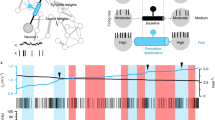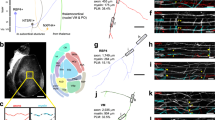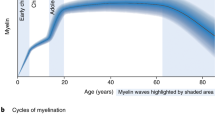Abstract
One of the most significant paradigm shifts in membrane remodeling is the emerging view that membrane transformation is not exclusively controlled by cytoskeletal rearrangement, but also by biophysical constraints, adhesive forces, membrane curvature and compaction. One of the most exquisite examples of membrane remodeling is myelination. The advent of myelin was instrumental in advancing the nervous system during vertebrate evolution. With more rapid and efficient communication between neurons, faster and more complex computations could be performed in a given time and space. Our knowledge of how myelin-forming oligodendrocytes select and wrap axons has been limited by insufficient spatial and temporal resolution. By virtue of recent technological advances, progress has clarified longstanding controversies in the field. Here we review insights into myelination, from target selection to axon wrapping and membrane compaction, and discuss how understanding these processes has unexpectedly opened new avenues of insight into myelination-centered mechanisms of neural plasticity.
This is a preview of subscription content, access via your institution
Access options
Subscribe to this journal
Receive 12 print issues and online access
$209.00 per year
only $17.42 per issue
Buy this article
- Purchase on Springer Link
- Instant access to full article PDF
Prices may be subject to local taxes which are calculated during checkout



Similar content being viewed by others
References
Hartline, D.K. & Colman, D.R. Rapid conduction and the evolution of giant axons and myelinated fibers. Curr. Biol. 17, R29–R35 (2007).
Zalc, B., Goujet, D. & Colman, D. The origin of the myelination program in vertebrates. Curr. Biol. 18, R511–R512 (2008).
Ben Geren, B. The formation from the Schwann cell surface of myelin in the peripheral nerves of chick embryos. Exp. Cell Res. 7, 558–562 (1954).
Bunge, M.B., Bunge, R.P. & Pappas, G.D. Electron microscopic demonstration of connections between glia and myelin sheaths in the developing mammalian central nervous system. J. Cell Biol. 12, 448–453 (1962).
Eshed-Eisenbach, Y. & Peles, E. The making of a node: a co-production of neurons and glia. Curr. Opin. Neurobiol. 23, 1049–1056 (2013).
Normand, E.A. & Rasband, M.N. Subcellular patterning: axonal domains with specialized structure and function. Dev. Cell 32, 459–468 (2015).
Waxman, S.G. Determinants of conduction velocity in myelinated nerve fibers. Muscle Nerve 3, 141–150 (1980).
Waxman, S.G. Axon-glia interactions: building a smart nerve fiber. Curr. Biol. 7, R406–R410 (1997).
Babbs, C.F. & Shi, R. Subtle paranodal injury slows impulse conduction in a mathematical model of myelinated axons. PLoS One 8, e67767 (2013).
Fields, R.D. White matter in learning, cognition and psychiatric disorders. Trends Neurosci. 31, 361–370 (2008).
Pajevic, S., Basser, P.J. & Fields, R.D. Role of myelin plasticity in oscillations and synchrony of neuronal activity. Neuroscience 276, 135–147 (2014).
Hildebrand, C., Remahl, S., Persson, H. & Bjartmar, C. Myelinated nerve fibres in the CNS. Prog. Neurobiol. 40, 319–384 (1993).
Wang, S.S. et al. Functional trade-offs in white matter axonal scaling. J. Neurosci. 28, 4047–4056 (2008).
Salzer, J.L. Schwann cell myelination. Cold Spring Harb. Perspect. Biol. 7, a020529 (2015).
Mei, L. & Nave, K.A. Neuregulin-ERBB signaling in the nervous system and neuropsychiatric diseases. Neuron 83, 27–49 (2014).
Brinkmann, B.G. et al. Neuregulin-1/ErbB signaling serves distinct functions in myelination of the peripheral and central nervous system. Neuron 59, 581–595 (2008).
Mirsky, R. et al. Myelin-specific proteins and glycolipids in rat Schwann cells and oligodendrocytes in culture. J. Cell Biol. 84, 483–494 (1980).
Aggarwal, S. et al. A size barrier limits protein diffusion at the cell surface to generate lipid-rich myelin-membrane sheets. Dev. Cell 21, 445–456 (2011).
Rosenberg, S.S., Kelland, E.E., Tokar, E., De la Torre, A.R. & Chan, J.R. The geometric and spatial constraints of the microenvironment induce oligodendrocyte differentiation. Proc. Natl. Acad. Sci. USA 105, 14662–14667 (2008).
Lee, S. et al. A culture system to study oligodendrocyte myelination processes using engineered nanofibers. Nat. Methods 9, 917–922 (2012).
Foran, D.R. & Peterson, A.C. Myelin acquisition in the central nervous system of the mouse revealed by an MBP-Lac Z transgene. J. Neurosci. 12, 4890–4897 (1992).
Brody, B.A., Kinney, H.C., Kloman, A.S. & Gilles, F.H. Sequence of central nervous system myelination in human infancy. I. An autopsy study of myelination. J. Neuropathol. Exp. Neurol. 46, 283–301 (1987).
Kinney, H.C., Brody, B.A., Kloman, A.S. & Gilles, F.H. Sequence of central nervous system myelination in human infancy. II. Patterns of myelination in autopsied infants. J. Neuropathol. Exp. Neurol. 47, 217–234 (1988).
Piaton, G., Gould, R.M. & Lubetzki, C. Axon-oligodendrocyte interactions during developmental myelination, demyelination and repair. J. Neurochem. 114, 1243–1260 (2010).
Taveggia, C., Feltri, M.L. & Wrabetz, L. Signals to promote myelin formation and repair. Nat. Rev. Neurol. 6, 276–287 (2010).
Tomassy, G.S. et al. Distinct profiles of myelin distribution along single axons of pyramidal neurons in the neocortex. Science 344, 319–324 (2014).
Ramón y Cajal, S. Degeneration & Regeneration of the Nervous System (Oxford Univ. Press, London, 1928).
Robertson, J.D. The ultrastructure of adult vertebrate peripheral myelinated nerve fibers in relation to myelinogenesis. J. Biophys. Biochem. Cytol. 1, 271–278 (1955).
Bunge, R.P., Bunge, M.B. & Bates, M. Movements of the Schwann cell nucleus implicate progression of the inner (axon-related) Schwann cell process during myelination. J. Cell Biol. 109, 273–284 (1989).
Webster, H.D. The geometry of peripheral myelin sheaths during their formation and growth in rat sciatic nerves. J. Cell Biol. 48, 348–367 (1971).
Fraher, J.P. A quantitative study of anterior root fibres during early myelination. II. Longitudinal variation in sheath thickness and axon circumference. J. Anat. 115, 421–444 (1973).
Fraher, J.P. Quantitative studies on the maturation of central and peripheral parts of individual ventral motoneuron axons. I. Myelin sheath and axon calibre. J. Anat. 126, 509–533 (1978).
Ioannidou, K., Anderson, K.I., Strachan, D., Edgar, J.M. & Barnett, S.C. Time-lapse imaging of the dynamics of CNS glial-axonal interactions in vitro and ex vivo. PLoS One 7, e30775 (2012).
Sobottka, B., Ziegler, U., Kaech, A., Becher, B. & Goebels, N. CNS live imaging reveals a new mechanism of myelination: the liquid croissant model. Glia 59, 1841–1849 (2011).
Möbius, W. et al. Electron microscopy of the mouse central nervous system. Methods Cell Biol. 96, 475–512 (2010).
Peddie, C.J. & Collinson, L.M. Exploring the third dimension: volume electron microscopy comes of age. Micron 61, 9–19 (2014).
Czopka, T., Ffrench-Constant, C. & Lyons, D.A. Individual oligodendrocytes have only a few hours in which to generate new myelin sheaths in vivo. Dev. Cell 25, 599–609 (2013).
Snaidero, N. et al. Myelin membrane wrapping of CNS axons by PI(3,4,5)P3-dependent polarized growth at the inner tongue. Cell 156, 277–290 (2014).
Nawaz, S. et al. Actin filament turnover drives leading edge growth during myelin sheath formation in the central nervous system. Dev. Cell 34, 139–151 (2015).
Zuchero, J.B. et al. CNS myelin wrapping is driven by actin disassembly. Dev. Cell 34, 152–167 (2015).
Chomiak, T. & Hu, B. What is the optimal value of the g-ratio for myelinated fibers in the rat CNS? A theoretical approach. PLoS One 4, e7754 (2009).
Peters, A. Further observations on the structure of myelin sheaths in the central nervous system. J. Cell Biol. 20, 281–296 (1964).
Waxman, S.G. & Swadlow, H.A. Ultrastructure of visual callosal axons in the rabbit. Exp. Neurol. 53, 115–127 (1976).
Nave, K.A. & Salzer, J.L. Axonal regulation of myelination by neuregulin 1. Curr. Opin. Neurobiol. 16, 492–500 (2006).
Jahn, O., Tenzer, S. & Werner, H.B. Myelin proteomics: molecular anatomy of an insulating sheath. Mol. Neurobiol. 40, 55–72 (2009).
Bird, T.D., Farrell, D.F. & Sumi, S.M. Brain lipid composition of the shiverer mouse: (genetic defect in myelin development). J. Neurochem. 31, 387–391 (1978).
Privat, A., Jacque, C., Bourre, J.M., Dupouey, P. & Baumann, N. Absence of the major dense line in myelin of the mutant mouse “shiverer”. Neurosci. Lett. 12, 107–112 (1979).
Rosenbluth, J. Central myelin in the mouse mutant shiverer. J. Comp. Neurol. 194, 639–648 (1980).
Harauz, G., Ladizhansky, V. & Boggs, J.M. Structural polymorphism and multifunctionality of myelin basic protein. Biochemistry 48, 8094–8104 (2009).
Harauz, G. & Libich, D.S. The classic basic protein of myelin–conserved structural motifs and the dynamic molecular barcode involved in membrane adhesion and protein-protein interactions. Curr. Protein Pept. Sci. 10, 196–215 (2009).
Nawaz, S. et al. Phosphatidylinositol 4,5-bisphosphate-dependent interaction of myelin basic protein with the plasma membrane in oligodendroglial cells and its rapid perturbation by elevated calcium. J. Neurosci. 29, 4794–4807 (2009).
Kattnig, D.R., Bund, T., Boggs, J.M., Harauz, G. & Hinderberger, D. Lateral self-assembly of 18.5-kDa myelin basic protein (MBP) charge component-C1 on membranes. Biochim. Biophys. Acta 1818, 2636–2647 (2012).
Aggarwal, S. et al. Myelin membrane assembly is driven by a phase transition of myelin basic proteins into a cohesive protein meshwork. PLoS Biol. 11, e1001577 (2013).
Lee, D.W. et al. Lipid domains control myelin basic protein adsorption and membrane interactions between model myelin lipid bilayers. Proc. Natl. Acad. Sci. USA 111, E768–E775 (2014).
Palaniyar, N., Semotok, J.L., Wood, D.D., Moscarello, M.A. & Harauz, G. Human proteolipid protein (PLP) mediates winding and adhesion of phospholipid membranes but prevents their fusion. Biochim. Biophys. Acta 1415, 85–100 (1998).
Bizzozero, O.A. & Howard, T.A. Myelin proteolipid protein-induced aggregation of lipid vesicles: efficacy of the various molecular species. Neurochem. Res. 27, 1269–1277 (2002).
Bakhti, M. et al. Loss of electrostatic cell-surface repulsion mediates myelin membrane adhesion and compaction in the central nervous system. Proc. Natl. Acad. Sci. USA 110, 3143–3148 (2013).
Klugmann, M. et al. Assembly of CNS myelin in the absence of proteolipid protein. Neuron 18, 59–70 (1997).
Möbius, W., Patzig, J., Nave, K.A. & Werner, H.B. Phylogeny of proteolipid proteins: divergence, constraints, and the evolution of novel functions in myelination and neuroprotection. Neuron Glia Biol. 4, 111–127 (2008).
Coetzee, T., Suzuki, K., Nave, K.A. & Popko, B. Myelination in the absence of galactolipids and proteolipid proteins. Mol. Cell. Neurosci. 14, 41–51 (1999).
Inoue, Y., Nakamura, R., Mikoshiba, K. & Tsukada, Y. Fine structure of the central myelin sheath in the myelin deficient mutant Shiverer mouse, with special reference to the pattern of myelin formation by oligodendroglia. Brain Res. 219, 85–94 (1981).
Schnaar, R.L., Gerardy-Schahn, R. & Hildebrandt, H. Sialic acids in the brain: gangliosides and polysialic acid in nervous system development, stability, disease, and regeneration. Physiol. Rev. 94, 461–518 (2014).
Gravel, M. et al. Overexpression of 2′,3′-cyclic nucleotide 3′-phosphodiesterase in transgenic mice alters oligodendrocyte development and produces aberrant myelination. Mol. Cell. Neurosci. 7, 453–466 (1996).
Yin, X., Peterson, J., Gravel, M., Braun, P.E. & Trapp, B.D. CNP overexpression induces aberrant oligodendrocyte membranes and inhibits MBP accumulation and myelin compaction. J. Neurosci. Res. 50, 238–247 (1997).
Galiano, M.R. et al. A distal axonal cytoskeleton forms an intra-axonal boundary that controls axon initial segment assembly. Cell 149, 1125–1139 (2012).
Yoshimura, T. & Rasband, M.N. Axon initial segments: diverse and dynamic neuronal compartments. Curr. Opin. Neurobiol. 27, 96–102 (2014).
Seidl, A.H. Regulation of conduction time along axons. Neuroscience 276, 126–134 (2014).
Seidl, A.H., Rubel, E.W. & Harris, D.M. Mechanisms for adjusting interaural time differences to achieve binaural coincidence detection. J. Neurosci. 30, 70–80 (2010).
Richardson, W.D., Young, K.M., Tripathi, R.B. & McKenzie, I. NG2-glia as multipotent neural stem cells: fact or fantasy? Neuron 70, 661–673 (2011).
Zatorre, R.J., Fields, R.D. & Johansen-Berg, H. Plasticity in gray and white: neuroimaging changes in brain structure during learning. Nat. Neurosci. 15, 528–536 (2012).
Wang, S. & Young, K.M. White matter plasticity in adulthood. Neuroscience 276, 148–160 (2014).
de Hoz, L. & Simons, M. The emerging functions of oligodendrocytes in regulating neuronal network behaviour. Bioessays 37, 60–69 (2015).
Makinodan, M., Rosen, K.M., Ito, S. & Corfas, G. A critical period for social experience-dependent oligodendrocyte maturation and myelination. Science 337, 1357–1360 (2012).
Liu, J. et al. Impaired adult myelination in the prefrontal cortex of socially isolated mice. Nat. Neurosci. 15, 1621–1623 (2012).
Watkins, T.A., Emery, B., Mulinyawe, S. & Barres, B.A. Distinct stages of myelination regulated by γ-secretase and astrocytes in a rapidly myelinating CNS coculture system. Neuron 60, 555–569 (2008).
Yeung, M.S. et al. Dynamics of oligodendrocyte generation and myelination in the human brain. Cell 159, 766–774 (2014).
McKenzie, I.A. et al. Motor skill learning requires active central myelination. Science 346, 318–322 (2014).
Li, Q., Brus-Ramer, M., Martin, J.H. & McDonald, J.W. Electrical stimulation of the medullary pyramid promotes proliferation and differentiation of oligodendrocyte progenitor cells in the corticospinal tract of the adult rat. Neurosci. Lett. 479, 128–133 (2010).
Gibson, E.M. et al. Neuronal activity promotes oligodendrogenesis and adaptive myelination in the mammalian brain. Science 344, 1252304 (2014).
Goebbels, S. et al. Elevated phosphatidylinositol 3,4,5-trisphosphate in glia triggers cell-autonomous membrane wrapping and myelination. J. Neurosci. 30, 8953–8964 (2010).
Hines, J.H., Ravanelli, A.M., Schwindt, R., Scott, E.K. & Appel, B. Neuronal activity biases axon selection for myelination in vivo. Nat. Neurosci. 18, 683–689 (2015).
Mensch, S. et al. Synaptic vesicle release regulates myelin sheath number of individual oligodendrocytes in vivo. Nat. Neurosci. 18, 628–630 (2015).
Bergles, D.E., Roberts, J.D., Somogyi, P. & Jahr, C.E. Glutamatergic synapses on oligodendrocyte precursor cells in the hippocampus. Nature 405, 187–191 (2000).
Lin, S.C. & Bergles, D.E. Synaptic signaling between GABAergic interneurons and oligodendrocyte precursor cells in the hippocampus. Nat. Neurosci. 7, 24–32 (2004).
Kukley, M., Capetillo-Zarate, E. & Dietrich, D. Vesicular glutamate release from axons in white matter. Nat. Neurosci. 10, 311–320 (2007).
Ziskin, J.L., Nishiyama, A., Rubio, M., Fukaya, M. & Bergles, D.E. Vesicular release of glutamate from unmyelinated axons in white matter. Nat. Neurosci. 10, 321–330 (2007).
Virchow, R. Über das ausgebreitete Vorkommen einer dem Nervenmark analogen Substanz in den tierischen Geweben. Virchows Arch. Pathol. Anat. 6, 562–572 (1854).
Pérez-Cerdá, F., Sánchez-Gómez, M.V. & Matute, C. Pío del Río Hortega and the discovery of the oligodendrocytes. Front. Neuroanat. 9, 92 (2015).
Chang, K.J. & Rasband, M.N. Excitable domains of myelinated nerves: axon initial segments and nodes of Ranvier. Curr. Top. Membr. 72, 159–192 (2013).
Snaidero, N. & Simons, M. Myelination at a glance. J. Cell Sci. 127, 2999–3004 (2014).
Acknowledgements
The electron micrograph in Figure 1 is courtesy of K. Susuki at Wright State University with technical assistance from D. Townley and support from the Integrated Microscopy Core at Baylor College of Medicine, with funding from the US National Institutes of Health (NIH) (HD007495, DK56338 and CA125123), the Dan L. Duncan Cancer Center and the John S. Dunn Gulf Coast Consortium for Chemical Genomics. We thank P.-J. Lee for her insight, creativity and efforts in making the illustrations. We also thank A.J. Green and the members of the Chan laboratory for critical reading of the manuscript and insightful comments. This review was supported by National Multiple Sclerosis Society research grants (RG4541A3 and RG5203A4), NIH National Institute of Neurological Disorders and Stroke (NINDS) (R01NS062796) and the Rachleff Endowment to J.R.C. S.A.R. is supported by an NIH NINDS National Research Service Award (F31NS081905).
Author information
Authors and Affiliations
Corresponding author
Ethics declarations
Competing interests
The authors declare no competing financial interests.
Rights and permissions
About this article
Cite this article
Chang, KJ., Redmond, S. & Chan, J. Remodeling myelination: implications for mechanisms of neural plasticity. Nat Neurosci 19, 190–197 (2016). https://doi.org/10.1038/nn.4200
Received:
Accepted:
Published:
Issue Date:
DOI: https://doi.org/10.1038/nn.4200
This article is cited by
-
H2S-RhoA/ROCK Pathway and Glial Cells in Axonal Remyelination After Ischemic Stroke
Molecular Neurobiology (2023)
-
Environmental Deprivation Effects on Myelin Ultrastructure in Huntington Disease and Wildtype Mice
Molecular Neurobiology (2023)
-
Reactive gliosis in Alzheimer’s disease: a crucial role for cognitive impairment and memory loss
Metabolic Brain Disease (2022)
-
White matter tract conductivity is resistant to wide variations in paranodal structure and myelin thickness accompanying the loss of Tyro3: an experimental and simulated analysis
Brain Structure and Function (2022)
-
Hypomyelinating leukodystrophies — unravelling myelin biology
Nature Reviews Neurology (2021)



